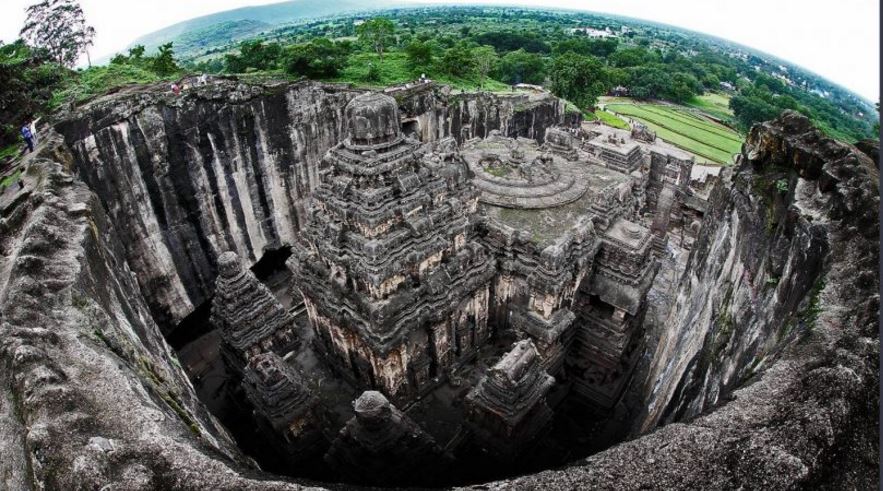
Spiritual
If one decides upon choosing one of the most wonderful countries, full of most astonishing events, dramas, cultures and traditions, stories, histories and happenings since most ancient of times, there is little doubt that India would be the numéro un choice for most of the people. India through its long prosperous and astonishing history has witnessed rise and fall of great kingdoms, played cradle to great personages that changed the course of its destiny, many a times, and seen knitting of great legends that had time and again, altered the character of its face. All these incredible phenomena have bequeathed it a wonderful and marvelous legacy that is conspicuous through its wonderful monuments, buildings, and sites; the beauty of which makes one fully comprehend the fantabulous eves and spells of time through which the country has passed.
Out of exceptionally rich compilation of most impressive structures, Kailash Temple in Aurangabad (Maharashtra, India), is one of the most majestic architectural marvels of India, which has always been a source of fascination due to its exquisite and exceptional architecture. The 145 feet wide, 195 feet long and 90 feet high Temple may not be officially declared as one of the awe-inspiring wonders of the world, but no one can really deny the greatness and sacredness of the Kailash Temple at Ellora.
Though magnificent in its glory and eminence, a clear exhibition of stupendous richness of Indian architecture, this wonderful edifice is an integral heritage of India. Situated around 30 km away from the city of Aurangabad, on the outskirts of Maharashtra, this rock cave temple of Ellora is the largest monolithic structure in the world. This enormous structure is one of the 34 cave temples and monasteries that are collectively famous as Ellora caves. Located in the south western region of Maharashtra, these Ellora caves are a UNESCO World Heritage Site and further include monuments dating between 600 CE and 1000 CE. While there are many impressive and mesmerizing structures round the corner, it’s the ever unique megalithic Kailash Temple that is perhaps, the most well-known, loved and visited.
Renowned both for its mysterious emergence and impressive ornamentation, it’s not entirely clear who had built Kailash Temple. While there are no written records about the construction, scholars generally attribute it to Rachtrakuta King Krishna 1, who ruled from about 756 CE to 773 CE. This attribution is based on the several epigraphs that connect the temple, in some way or the other, to “Krishnaraja”, though, nothing written directly about the ruler, contains any information about the temple.
Covering twice the area of Parthenon in Athens and being half as high again, Kailash Temple is an engineering masterpiece that was executed straight from head to ground with zero margin for error. The artist designed the temple to resemble the abode of Lord Shiva, Mount Kailash. When it was monitored closely, the experts found out that initially, artists had plastered the entire temple with white color, so that it can harmonize Mount Kailash. It’s pyramidal structure also resembles the mountain.
While scholars have yet to discover its true origin, a medieval legend paints a hypothetical picture behind the majestic temple. Based on a story written in katha-kalpataru by Krishna Yajnavalki, when a king was severely sick and was on his death bed, his queen prayed to God Shiva for her husband’s life. In return for his health and life, the queen promised to construct a temple in Shiva’s name and sit on fast until the shikhara(peak) of the temple gets fully completed. Gradually, the king became better and construction began on the temple, but, to the couple’s horror, they realized that it would take years for the shikhara to emerge. Luckily, a clever engineer came along an idea and explained to them that by starting from the top of the Charanandri mountains, he could easily make the temple’s shikhara appear within a week. This was so much to the relief of the queen, who could quickly finish her fast and thus, the temple was constructed from top to bottom.
One of India’s greatest monuments and the center of undented faith of Hindus, this astonishing temple was carved out of a single rock on the Charanandri Hills at Ellora. The temple is one of the world’s oldest single-rock carving and multi-storeyed complexes, which doesn’t reveal any date or depict a name; indicating that the carving dates back, hundreds and thousands of years. No one exactly knows about the origins, the builders and the architects of the temple.
One of the widely unimaginable and mysterious facts of Kailash Temple is it’s top to bottom carving. Even today, it is simply impossible to carve such a perfect piece of construction from top to bottom so elaborately, even by using highly advanced machines and equipments. The architecture of Kailash Temple has always remained notable for its vertical excavation, the work started from the top and moved downwards, rolling down the massive boulders split from the mountain using steel rod drills. One can see the drill marks on the corresponding walls that are still visible. A majestic megalithic structure, carved out of a single volcanic rock; Kailash Temple is the only structure in the world that is carved from top to bottom. Every single design and measurement was planned very accurately as once, it was cut, there was no chance of changing it by adding any extra stone or piece of rock. Not even a smallest piece of rock was joined separately for any extra design or additional support. Now, can you imagine how they managed to construct bridges, elevated balconies, staircases with multiple levels, underground tunnels, drainage and water harvesting system? Amazing! Isn’t it?
According to historians, it is estimated that approximately 2,00,000 tons – 4,00,000 tons of volcanic rock was removed from the site during construction of this temple. This sheer amount of rock was never seen or found, even not till date. Where was it re-used or dumped, is an unanswered question. Moreover, historians confirm that it was constructed in less than 18 years. That means, back in those years, 2 lakhs – 4lakhs tons of heavy rock was scooped out using ordinary equipment like hammers, blades and cutters and the temple was ready with exceptionally beautiful and intricate carvings, to be worshipped-in, in just 18 years.
The largest and the most elaborative among the other cave temples, Kailash stands about three stories tall, a horseshoe-shaped courtyard has a Gopuram(tower) at its entrance. Given the echoing space and the ornate decorations, the temple houses, a number of intricately carved panels, depicting scenes and incidences from the Ramayana, Mahabharata and the life adventures of Lord Krishna. In addition to this, worth admiring, are the immense monolithic pillars, which stand in the vast courtyard, flanking the entrance on both sides, and the south eastern gallery, that has 10 giant and elegant panels. The enormous stone carvings depicting different Hindu deities with special attention given to Lord Shiva. As one walks past the Gopuram, panels on the left show avatars(incarnations) of Lord Shiva, while panels on the right depict avatars of Lord Vishnu.
The Kailash Temple has a number of subsidiary shrines, that on a closer study, show an architectural style pertaining to different phases of Hindu Mythology. The temple had once been painted in a style that might have seemed suitable to its elaborate architecture and sculptures. Today, the paintings show signs and evidences of being renewed over time and again, but in a poorer and ugly style. At the base of the temple, a herd of carved elephants appear to carry the load of the temple on their backs.
The history tells us that during the reign of the Mughal emperor, Aurangzeb, around 1682, the temple was ordered to be demolished along with the other Hindu temples nationwide. For this particular task, he sent over 1000 labourers specially to destroy Kailash Temple. The labourers worked day and night for over 3 years but could barely manage to disfigure a few statues and cause minor damages here and there. Despite of his repeated efforts to tear the Temple apart, Aurangzeb tasted defeat. He finally gave up, fearing the sacredness of this divine place of worship and realized, that the rock carved temple was simply too hard to be broken; even though artisans used only hammers, chisels and picks to construct it.
Kailash Temple has the world’s largest cantilevered rock ceiling which seems just an impossible feat for temple constructed thousands of years ago. According to the Vedic tradition, prior to starting the construction of the Kailash Temple, the sculptors and architects performed a Mahayagna and asked for the permission of the rock to build the temple. The priests sanctified and energized the rocks by chanting pious and much powerful mantras. That’s why, even today, when people murmur or chant mantras, it’s echo resonates and vibrates around there in a peculiar way. The way sound travels and vibrates within the walls and pillars of the temples is an indication that the place carries divine blessings from Indian sages. Every aspect of the temple represents the sacredness of Hindu culture and pious intentions behind the construction.
One of the most fascinating and equitably mysterious facts about Kailash Temple is that, many scientists and researchers believe that the construction belongs to outer space because it is simply impossible to construct the biggest monolithic architecture, thousands of years ago without any technology. The unique way in which the holes are drilled, is one of the biggest mysteries for everyone. The holes indicate that someone very small drilled it as human beings cannot enter and do the drilling. The numerous shafts, narrow and even narrower lanes, and holes make you wonder whether they would have used something like computers to carry out the job.
Some researchers strongly claim the existence of a huge underground civilization under these caves as there are many deep tunnels and narrow passages in Ellora caves, which, after 10 feet or so, get too narrow for a human to enter. There are many tunnels and entry to many of such tunnels are restricted now. You can see bars and locks at the entry of the caves, having such tunnels. What was the purpose of such tunnels and narrow passages? Those narrow passages have been constructed properly and so elegantly for some purpose. If human can’t even enter those passages, how they made it and what for purpose? Can there be a hidden underground city? Was this all made by tiny humanoids? In addition, there are many ventilation shafts and holes on the floor of all the caves. No one has ever found the actual reason behind these holes. Were these specially designed for air circulation for underground city? Apart from this, all the wall paintings and carvings depict existence of an underground civilization and tiny humanoids. Carvings on the walls have big images of Gods and Goddesses and below a level, tiny humanoids and animals are shown. One of the carvings depict God Shiva and Goddess Parvati and underground tiny humanoids.
The architecture and design of Kailash Temple is much more advanced than that of other cave temples. Moreover, this is one of the many structures noticeable from the air. Because of the circular design and massive statues of four lions on the terrace, aerial view of kailash Temple shows a big “X” mark. Was that created as a signal for extra-terrestrials to spot the location?
This temple is one of the most mysterious architectures of the world and continues to remain a mystery. While visiting Kailash Temple in the silence of the dawn, one can’t help but, bow down in serenity and gratitude towards the ones who designed and built this majestic reminder of ever divinely surreal past. One may leave the senses behind to find the ‘real’ and communicate in solitude with what is beyond the mind.
Nothing here means just a decoration, everything bears a message to tell. Every wall and each pillar speaks the divine and heavenly language and further comes with a legacy. But only the heart can read it. There are keys, some are easy to find, others are only for the time when mankind is ready to realize, understand and accept the majestic nature of life. Officially, it is a Hindu temple but, eventually, it’s a lot more than that. Kailash Temple is one of the holiest sites on earth, a keeper of faith and wisdom, a preserver of the lost essence and supreme knowledge of life. It is there for all those who want to retire to the ever-forgiving shade of god. Among all the incredible temples of India and the world, this magnificent temple of Lord Shiva has fascinated countless and is worth paying homage.
By Maulshree


